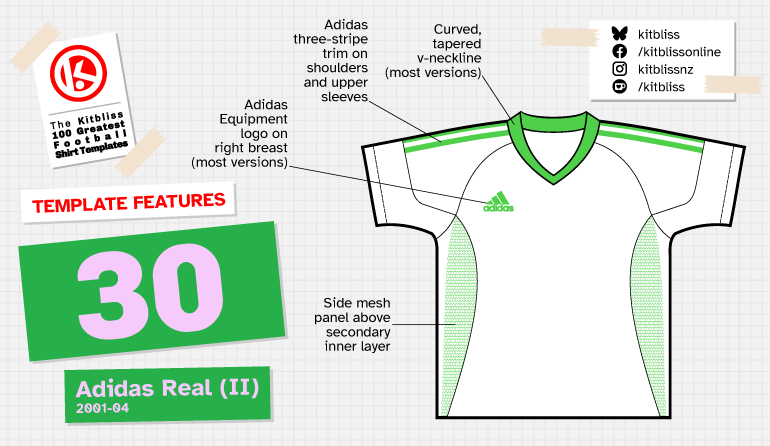30. Adidas Real (II) (2001-04)

Chris Oakley | 18 October 2025
While aesthetic originality has long been common in football shirt design, structural innovation has been far rarer. Around the 2002 FIFA World Cup, however, a new approach emerged — one that briefly redefined what the ideal shirt could be.
Enter the dual-layer football shirt — designed to wick sweat away from the body more efficiently and keep players cooler during a match. Both Adidas and Nike created their own self-aerating shirts in time for the World Cup in Japan and South Korea, and each version was markedly different in its method of improving athletic performance.

From left: AIK (2002 home), Argentina (2002-03 home), Bayer Leverkusen (2002-04 home), Ferencváros (2002 home).
Adidas’ ‘Climacool’ solution incorporated an underlayer to manage perspiration, while the sides of the upper layer featured a mesh-like material. This allowed ventilation to further regulate body temperature, while at the same time allowing the colour of the underlayer to be seen through the holes of the mesh. Cunning.
One suspects the appearance of a subtle secondary colour was an accidental by-product of perforating the side panels rather than a deliberate choice, but no matter. This was something we’d not really seen before, and Adidas deserve full credit for creating something so original.

From left: Finland (2003 home), France (2002-03 home), Hungary (2002-04 home), Liechtenstein (2002-03 home).
Such as it is, I remember being sceptical at the time about how much cooler the body would be as a result of those mesh segments. Furthermore, I wondered whether every new Adidas football shirt would now be built this way. To this day, I still don’t know the answer to the first question, but the second soon became easier to address. In short, only the premium teams partnering with Adidas received true dual-layer shirts, while the others had single-layer shirts that used sublimation to create the same visual effect.
Even from the outset, however, some elite teams didn’t wear an underlayer in a contrasting colour, missing out on some extra optical definition on the sides of the shirt. Germany wore a white Real (II) shirt from their first game of the 2002 World Cup to the final, but there was no hint of an accent colour to be seen (apart from the black neckline and cuffs). Several other teams adopted a similar approach, although special mention has to be made for Argentina. Their home shirt used white mesh panels as pseudo stripes to form an integral part of the classic Albiceleste design.

From left: New Zealand (2003 away), River Plate (2002 home), Romania (2002-04 home), Schalke 04 (2002-04 home).
Beyond the dual-layer aspect of the shirt, there was nothing but simplicity to observe. Every version had either a curved v-neckline or crew neck, and many were presented (along with the cuffs) in the same colour as the rest of the shirt. With stylised raglan sleeves featuring truncated Adidas stripes, the intent was clearly to avoid burdening the whole thing with unnecessary detail. In that regard, Adidas certainly succeeded.
They also did well to ensure their template was worn by great teams who were getting plenty of attention in the early part of the new millennium. As well as Germany and Argentina, Spain, Sweden, France, Saudi Arabia, Turkey, South Africa and China all wore Real (II) at the 2002 World Cup, while a year later, New Zealand did the same at the 2003 Confederations Cup. Seemingly every other national team in Europe were wearing it too, along with clubs all the way from River Plate to Rosenborg.

From left: South Africa (2002-03 home), Spain (2001-03 home), Sweden (2002 home), Turkey (2002-03 away).
This was a likeable, versatile template. Though its dual-layer credentials didn’t last long in their original form, it earned its place as a noteworthy step toward a new era in shirt design. With materials becoming ever more light in weight and production techniques improving in the years that followed, it could even be argued that this was what instigated the start of the modern-day football shirt revolution.
My grateful thanks go to Jay, Adam’s Shirt Quest and FSWorld for their help in researching this template, and to Lucas Silveira Santos for providing its official name.
To see the full set of Adidas Real (II) kits, visit the Adidas Real (II) template gallery page.
